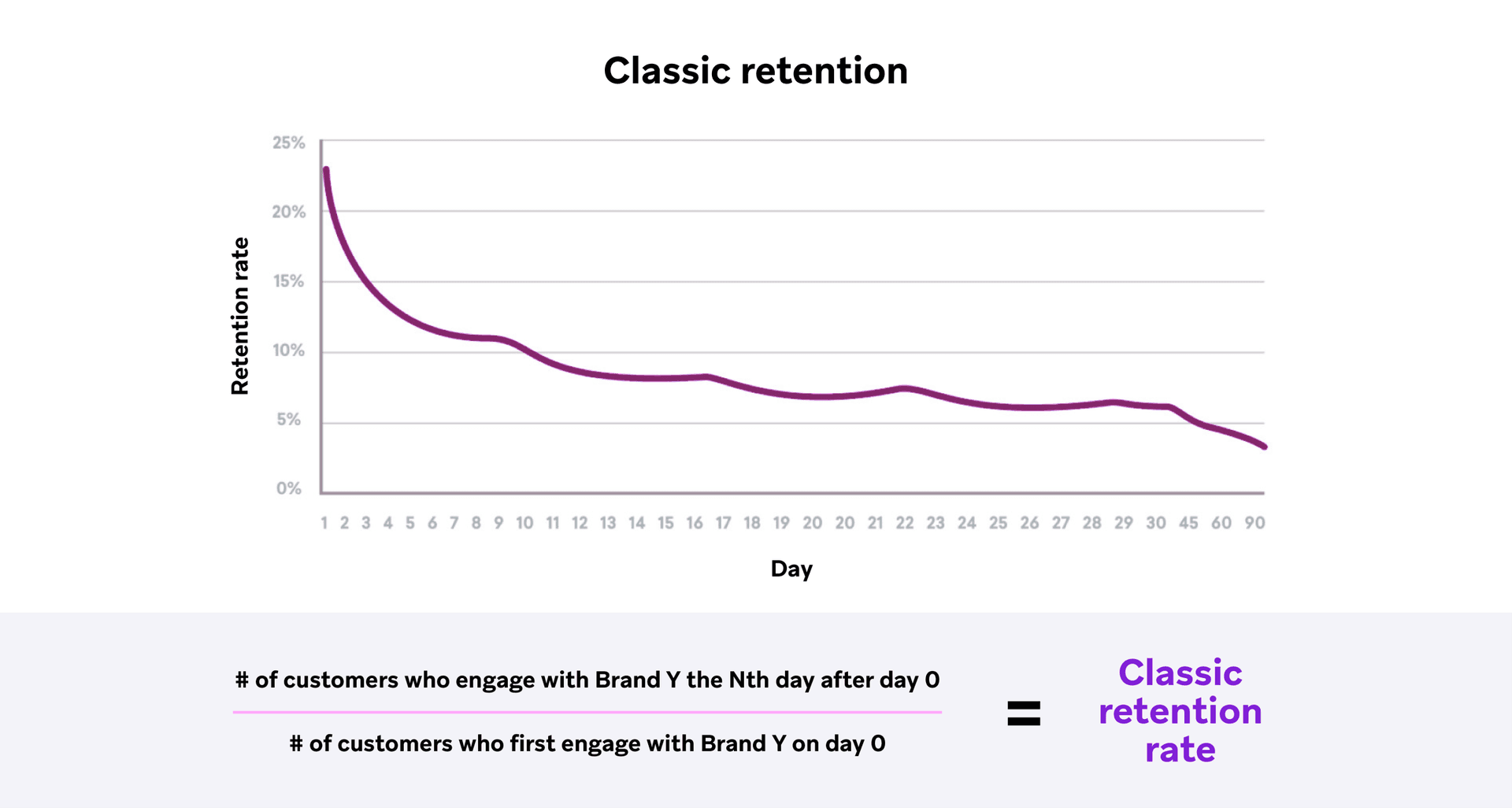The Many Faces of Retention: What It Is, How to Measure It, and Smart Ways to Boost It
Published on March 29, 2024/Last edited on March 29, 2024/6 min read


Team Braze
The story of customer engagement has always been an evolving one. Following the launch of the first iPhone and the mobile revolution that followed, many brands treated mobile apps like a modern gold rush, leading them to throw good money after bad in hopes of acquiring as many new app users as humanly possible. A small number of companies managed to build massive followings, but many saw their new customers vanish as quickly as they came. Back then, adding new users was cheap, allowing teams to get away with increasing their acquisition velocity without ever having to face their churn challenges head on.
That’s no longer the world most companies are operating in. As the digital landscape has grown more crowded and costs have shot up, we’ve seen retention becoming an increasingly big part of the customer engagement landscape. In the 2024 Global Customer Engagement Review, 42% of surveyed brands said they spend the bulk of the marketing budget on retention, only a few points behind the 45% of surveyed companies who focus most of their spending on acquisition.
Brands that don’t prioritize retention run the risk of undermining their ability to successfully build sustainable customer relationships and hit their business goals. To help out, we’ll be taking a look at the nuts and bolts of retention—what it is, how to measure it effectively, and how to hold onto more customers over time.
What is customer retention?
Customer retention occurs when businesses successfully hold onto customers they acquire over a specific time frame. This happens when brands can find ways to encourage them to continue engaging beyond an initial interaction or purchase. In general, successful retention occurs when customers:
- Actively engage with your brand across various channels
- Regularly do business with your brand
- Take high-value actions beyond their first conversion (e.g. setting up an account with your company, subscribing to your emails, consuming your content, or making repeat purchases)
- View your company as a brand of choice
When a brand prioritizes retaining their acquired customers with specific campaigns and journeys aimed at developing long-term relationships, that’s known as retention marketing. This marketing tends to prioritize understanding and meeting customer needs to incentivize them to stick around—and build the kinds of long-term relationships that drive sustainable growth. In general, successful retention marketing programs:
- Deliver relevant experiences that keep customers engaged with your brand and its offerings
- Successfully encourage repeated high-value actions (e.g. website visits, app sessions, purchases, membership renewals)
- Prevent at-risk users from churning
- Help to re-engage lapsing and inactive customers
Retention marketing is just one part of most brands’ larger marketing efforts, but there’s reason to think that it should be playing a central role. Why? Because customer retention is one of the most impactful things that a marketing team can focus on.
In general, customer retention is just more cost-effective than acquisition: It costs 6-7X more to acquire new customers than to get existing customers to make repeat purchases. And an effective retention marketing program can have a positive impact on a company’s efforts, boosting cost savings, driving more conversion and purchases, increasing profits, and uplifting customer lifetimes and lifetime value.
How should marketers measure retention?
Okay, so retention is important—but how can marketers tell how many users they’re holding onto over time? The truth is, there are many different ways for brands to measure their retention rate. Each method has different pros and cons, making it important for marketers to be thoughtful when they decide how to track their ability to hold onto customers.

One of the most traditional methods for calculating retention is classic retention, which measures the portion of customers who are still engaging with your brand vs. the total number of individuals acquired over a given period of time. It’s useful if you’re looking to get a high-level picture of how long customers continue to engage with your company, but it’s not the only way to understand retention. Some other common methods include:
- Range retention: This method measures customer retention over a given range of time (often seven, 30, or 90 days). It’s ideal for brands with customers who tend toward weekly (e.g. streaming brands with weekly episode premieres) or monthly (e.g. fitness brands with monthly subscriptions) engagement.
- Rolling retention: This method measures the percentage of new users who return to your app, website, or other digital property on or after a specific day. It’s ideal for brands who tend to have less frequent engagement (e.g. home, auto, or life insurance), as this indicates the portion of users who are continuing to engage, even if it’s not as often as it would be for other types of products or services.
- Purchase retention: This method specifically measures when a customer last made a purchase. It’s ideal for retail and eCommerce brands and any other verticals where purchases are core to their value proposition and business model, since it allows them to focus their retention efforts on regular buyers, rather than mere browsers.
How can brands boost their retention outcomes?
There are a number of different ways to improve your customer retention outcomes, from building out an effective onboarding program to embracing nuanced personalization. But the key to any successful strategy is embracing cross-channel engagement.
Research conducted by Braze has found that leveraging specific combinations of messaging channels can allow marketers to significantly drive up retention rates, supporting stronger relationships and business performance. Our analysis determined that using multiple channels in the right mix is a simple, effective way to move the needle:
- With each new channel marketers add to their messaging mix (for a total of up to six channels), participating brands see an average 56% uplift in 90-day retention.
- Communicating via both in-product and out-of-product messaging sees a 61% uplift in 90-day retention compared to out-of-product channels alone and a 1.4X uplift in 90-day retention compared to only in-product channels.
- Across the industries we studied, email, in-app messaging, mobile push, and web push have a 80% retention rate—58% higher than email alone.
Final thoughts
As a larger percentage of overall marketing spend is earmarked for retention efforts and overall spending is under scrutiny, we expect that finding ways to do retention right and take advantage of the tools at marketers’ disposal will increasingly become a strategic advantage. Interested in digging deeper into retention marketing? Check out our exclusive retention guide.
Methodology
For this analysis, Braze pulled anonymized and aggregated behavioral data from nearly 1,000 Braze customers to analyze app activity, message engagement, and purchasing trends by industry. These statistics span January 1, 2023 to December 31, 2023 and include data from over 9 billion users and 30 sub-industries. All metrics have been cleaned using volume and company count checks so that no one brand or group of brands is over-represented. All uplift figures greater than 100% are rounded to the nearest decimal point, and all uplift figures below 100% are rounded to the nearest whole percent. When comparing two rounded numbers, percent change metrics are calculated as the difference between the two numbers after rounding.
Related Tags
Be Absolutely Engaging.™
Sign up for regular updates from Braze.
Related Content
View the Blog
A day in the life of a data scientist on the BrazeAIᵀᴹ forward-deployed engineering team

McKay Jensen

The new inbox reality: How iOS changes are reshaping email marketing

Aparna Prasad

Experience optimization: Turning data insights into better journeys
